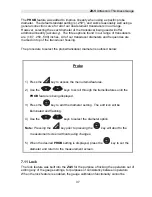
28
CHAPTER SEVEN
ADDITIONAL FEATURES
7.1 Gain
The gain, or amplification of the return echoes, can be adjusted in the
ZX-5
to
accommodate a variety of materials and applications. The setting of the gain is
crucial in order to obtain valid readings during the measurement process. Too much
gain may result in erroneous measurements, detecting on noise rather than the
actual material back wall surface. Not enough gain may result in intermittent
detection. It could also result in lack of detection on internal flaws, pits, or porosity.
The gain can be compared to the volume control of a home stereo system. If you
turn it up too much, you can’t hear the music clearly. If it’s turned down too much,
you can’t hear it at all.
The
ZX-5
has five gain settings
(VLOW, LOW, MED, HIGH, VHI)
. The gain range is
40dB – 52dB in 3dB increments. The
ZX-5
has been optimized for the
MED
gain
setting at 46dB for all common applications. It should be operated in this mode as
standard. However, some applications may require the lower or higher gain settings.
When? The low settings may be necessary for noisy or granular cast materials. How
do I know when to lower the gain? If the reading becomes sporadic and won’t settle
down or resolve on a thickness value because the material is either very noisy or
granular. Setting the gain to a lower less sensitive level, would potentially offer
improved stability.
How do I know when to increase the gain? When a material is difficult to penetrate or
pass sound through. This could be due to the material type, overall thickness, the
transducer diameter and frequency, or a combination of all the above. Turning the
gain up for additional output could improve the ability to obtain a successful
measurement. Another example would be the need to increase overall sensitivity for
locating fine pits or flaws. In any case, the selectable gain settings offer improved
versatility to resolve and overcome potential application issues.
The procedure for editing the gain is outlined as follows:
GAIN
















































